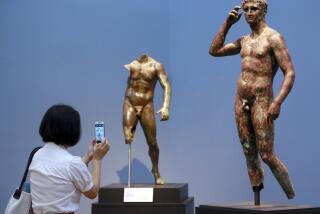Museum directors agree on antiquities guidelines
- Share via
Responding to a series of embarrassments in which major museums have had to return ancient artifacts obtained under questionable circumstances, America’s art museum directors have adopted stronger guidelines for antiquities acquisitions -- including honoring a 1970 U.N. declaration aimed at keeping relics in their homelands.
The J. Paul Getty Museum, New York’s Metropolitan Museum of Art and others have returned works to Italy and Greece in recent years, admitting that they had missed or downplayed evidence that the works were looted.
The new guidelines, adopted Tuesday in Detroit at the annual meeting of the Assn. of Art Museum Directors, replace ones in effect since 2004.
Besides advising museums not to touch works dug up after November 1970, when the United Nations Educational, Scientific and Cultural Organization (UNESCO) issued rules against looting, the guidelines call for photographs and written documentation of all newly acquired antiquities to be posted on the art museum directors group’s website.
“We’re establishing an unprecedented level of public transparency,” said Dan Monroe, director of the Peabody Essex Museum in Salem, Mass., who chaired the 20-member committee that wrote the guidelines.
When conclusive evidence is lacking despite “a rigorous effort,” the guidelines say, museums should balance the risks of embarrassment and financial loss against the educational and art-preservation benefits of owning a work whose origins remain gray.
Monroe said that by “reaffirming our value system,” the guidelines should help shore up museums’ case that they are worthy repositories for relics of the ancient past.
Museum values have been called into question by highly publicized controversies such as the claims against the Getty, including Italy’s prosecution of the museum’s former antiquities curator, Marion True. Lands of origin have argued not only that some of the works in foreign museums represent a stolen patrimony but also that they are best understood and appreciated in their home surroundings. Also, archaeologists are concerned that by collecting ancient art, museums risk fueling looting that ruins dig sites.
The committee that produced the guidelines included the Getty’s Michael Brand, Philippe de Montebello of the Metropolitan Museum of Art and James Cuno of the Art Institute of Chicago, whose recent book, “Who Owns Antiquity? Museums and the Battle Over Our Ancient Heritage,” defends foreign museums’ stewardship of antiquities.
--
More to Read
The biggest entertainment stories
Get our big stories about Hollywood, film, television, music, arts, culture and more right in your inbox as soon as they publish.
You may occasionally receive promotional content from the Los Angeles Times.











